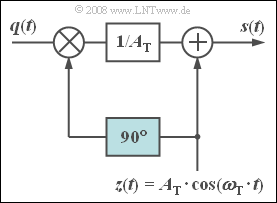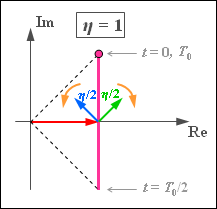Difference between revisions of "Aufgaben:Exercise 3.4: Simple Phase Modulator"
m |
m (→Questions) |
||
| Line 43: | Line 43: | ||
<quiz display=simple> | <quiz display=simple> | ||
| − | { | + | {Calculate the equivalent low-pass signal. Which statement is true? |
|type="()"} | |type="()"} | ||
| − | - | + | - The locus curve $s_{\rm TP}(t)$ is a circular arc. |
| − | - | + | - The locus curve $s_{\rm TP}(t)$ is a horizontal straight line. |
| − | + | + | + The locus curve $s_{\rm TP}(t)$ is a vertical straight line. |
| − | { | + | {Calculate the (normalized) envelope $a(t)$ for $A_{\rm T} = 1$. What are its minimum and maximum values when $η = 1$? |
|type="{}"} | |type="{}"} | ||
$a_{\rm min} \ = \ $ { 1 3% } | $a_{\rm min} \ = \ $ { 1 3% } | ||
$a_{\rm max} \ = \ $ { 1.414 3% } | $a_{\rm max} \ = \ $ { 1.414 3% } | ||
| − | { | + | {Calculate the maximum value of the phase $ϕ(t)$ for $η = 1$ and $η = 0.5$. |
|type="{}"} | |type="{}"} | ||
$η = 1.0\text{:} \ \ \ ϕ_{\rm max} \ = \ $ { 45 3% } $\ \rm Grad$ | $η = 1.0\text{:} \ \ \ ϕ_{\rm max} \ = \ $ { 45 3% } $\ \rm Grad$ | ||
$η = 0.5\text{:} \ \ \ ϕ_{\rm max} \ = \ $ { 26.6 3% } $\ \rm Grad$ | $η = 0.5\text{:} \ \ \ ϕ_{\rm max} \ = \ $ { 26.6 3% } $\ \rm Grad$ | ||
| − | { | + | {What are distortions result after ideal phase demodulation of $s(t)$? |
|type="()"} | |type="()"} | ||
| − | - | + | - No distortions occur. |
| − | - | + | - Linear distortions occur. |
| − | + | + | + Nonlinear distortions occur. |
| − | { | + | {Calculate the distortion factor $K$ considering the trigonometric relationships given on the exercise page. |
|type="{}"} | |type="{}"} | ||
$η = 1.0\text{:} \ \ \ K \ = \ $ { 11.1 3% } $\ \text{%}$ | $η = 1.0\text{:} \ \ \ K \ = \ $ { 11.1 3% } $\ \text{%}$ | ||
Revision as of 19:24, 14 March 2022
The adjacent circuit allows the approximate realization of a phase-modulated signal.
From the cosinusoidal carrier, $z(t)$ , the $90^\circ$ phase shifter forms a sinusoidal signal of the same frequency, such that the modulated signal can be written as:
- $$ s(t) = z(t) + q(t) \cdot \frac{z(t- T_0/4)}{A_{\rm T}} = A_{\rm T} \cdot \cos (\omega_{\rm T} \cdot t) + q(t) \cdot \sin (\omega_{\rm T} \cdot t) \hspace{0.05cm}.$$
The second term describes a "DSB–AM without carrier". Additionally, the carrier, phase-shifted by $90^\circ$ , is added. Thus, with a cosine source signal $q(t) = A_{\rm N} \cdot \cos (\omega_{\rm N} \cdot t)$ , we get:
- $$s(t) = A_{\rm T} \cdot \cos (\omega_{\rm T} \cdot t) + A_{\rm N} \cdot \cos (\omega_{\rm N} \cdot t) \cdot \sin (\omega_{\rm T} \cdot t) $$
- $$\Rightarrow \hspace{0.3cm}s(t) = A_{\rm T} \cdot \big[\cos (\omega_{\rm T} \cdot t) + \eta \cdot \cos (\omega_{\rm N} \cdot t) \cdot \sin (\omega_{\rm T} \cdot t) \big] \hspace{0.05cm}.$$
We refer to the ratio $η = A_{\rm N}/A_{\rm T}$ as the modulation index; in the following, the carrier amplitude is set to $A_{\rm T} = 1$ for simplicity.
- In contrast to ideal phase modulation the modulation index $η$ and the phase deviation $ϕ_{\rm max}$ may differ in this "approximate phase modulation".
- Additionally, we can see that the envelope $a(t) ≠ 1$ . This means that an unwanted amplitude modulation is superimposed on the phase modulation.
From the representation of the equivalent low-pass signal $s_{\rm TP}(t)$ in the complex plane (locus curve), the following are to be calculated in this task:
- the envelope $a(t)$ and
- the phase function $ϕ(t)$.
Then, you are to analyse the distortions arising when an ideal PM demodulator, which sets the sink signal $v(t)$ proportional to the phase $ϕ(t)$ , is used on the receiving side of this nonideal PM modulator.
Hints:
- This exercise belongs to the chapter Phase Modulation.
- Particular reference is made to the page Equivalent low-pass signal in phase modulation.
- You can use the following equations to approximate the distortion factor:
- $$\arctan(\gamma) \approx \gamma - {\gamma^3}/{3} \hspace{0.05cm}, \hspace{0.3cm} \cos^3(\gamma) ={3}/{4} \cdot \cos(\gamma) +{1}/{4} \cdot \cos(3 \cdot \gamma) \hspace{0.05cm}.$$
Questions
Solution
(1) Richtig ist der Lösungsvorschlag 3:
- Das äquivalente Tiefpass–Signal lautet:
- $$s_{\rm TP}(t) = A_{\rm T} \cdot \left ( 1 + {\rm j}\cdot \frac {\eta}{2}\cdot \left ({\rm e}^{\hspace{0.05cm}{\rm j} \hspace{0.05cm}\cdot \hspace{0.05cm}\omega_{\rm N} \hspace{0.05cm}\cdot \hspace{0.05cm} t} + {\rm e}^{\hspace{0.05cm}{-\rm j} \hspace{0.05cm}\cdot \hspace{0.05cm}\omega_{\rm N} \hspace{0.05cm}\cdot \hspace{0.05cm} t}\right) \right) = A_{\rm T} \cdot \big ( 1 + {\rm j}\cdot {\eta}\cdot \cos (\omega_{\rm N} \cdot t) \big)\hspace{0.05cm}.$$
- Die Grafik verdeutlicht, dass die Ortskurve $s_{\rm TP}(t)$ nun eine vertikale Gerade ist im Gegensatz zur idealen PM (Kreisbogen) und zur ZSB–AM (horizontale Gerade).
- Im Folgenden wird $A_{\rm T} = 1$ gesetzt.
(2) Die Hüllkurve ergibt sich aus der zeitabhängigen Zeigerlänge zu
- $$a(t) = \sqrt{1 + \eta^2 \cdot \cos^2 (\omega_{\rm N} \cdot t)} \hspace{0.3cm} \Rightarrow \hspace{0.3cm}a_{\rm min} \hspace{0.15cm}\underline { = 1}, \hspace{0.3cm}a_{\rm max} = \sqrt{1 + \eta^2 }\hspace{0.05cm}.$$
- Für $η = 1$ ergibt sich der Maximalwert zu $a_{\rm max} = \sqrt{2}\hspace{0.15cm}\underline { ≈ 1.414}$.
(3) Für die Phasenfunktion dieses einfachen Phasendemodulators gilt:
- $$\phi(t) = \arctan \frac{{\rm Im}[s_{\rm TP}(t)]}{{\rm Re}[s_{\rm TP}(t)]} = \arctan (\eta \cdot \cos (\omega_{\rm N} \cdot t)) \hspace{0.05cm}.$$
- Der Maximalwert tritt beispielsweise zur Zeit $t = 0$ auf und beträgt $ϕ_{\rm max} = \arctan(η)$.
- Für $η = 1$ erhält man $ϕ_{\rm max}\hspace{0.15cm}\underline { = 45^\circ}$ $($im Vergleich: Bei idealer PM $57.3^\circ)$,
- Für $η = 0.5$ ergibt sich $ϕ_{\rm max}\hspace{0.15cm}\underline { \approx 26.6^\circ}$ $($bei idealer PM $28.7^\circ)$.
(4) Richtig ist der Lösungsvorschlag 3:
- Es gilt nicht: $\arctan\big [η · \cos(γ)\big ] = η · \cos(γ)$.
- Das heißt, dass das Sinkensignal im Gegensatz zum Quellensignal nicht cosinusförmig verläuft.
- Dies weist auf nichtlineare Verzerrungen hin.
(5) Mit $γ = η · \cos(ω_N · t)$ und $\arctan(γ) ≈ γ – γ^3/3$ erhält man:
- $$ \phi(t) = \eta \cdot \cos (\omega_{\rm N} \cdot t) - \frac{\eta^3}{3}\cdot \cos^3 (\omega_{\rm N} \cdot t))= \eta \cdot \cos (\omega_{\rm N} \cdot t) - \frac{\eta^3}{3}\cdot \left [ {3}/{4}\cdot \cos (\omega_{\rm N} \cdot t) + {1}/{4}\cdot \cos (3 \omega_{\rm N} \cdot t)\right ] $$
- $$\Rightarrow \hspace{0.3cm} \phi(t) = \left(\eta - {\eta^3}/{4} \right) \cdot \cos (\omega_{\rm N} \cdot t) - {\eta^3}/{12}\cdot \cos (3\omega_{\rm N} \cdot t) \hspace{0.05cm}.$$
- Das bedeutet: Bei Verwendung der angegebenen Reihenentwicklung (Terme 5. und höherer Ordnung werden vernachlässigt) ist nur der Klirrfaktor dritter Ordnung von Null verschieden. Man erhält:
- $$K = K_3 = \frac{\eta^3/12}{\eta-\eta^3/4}= \frac{1}{12/\eta^2 -3} \hspace{0.05cm}.$$
- Für $η = 1$ ergibt sich der Zahlenwert $K = 1/9 \hspace{0.15cm}\underline { ≈ 11.1\%}$.
- Für $η = 0.5$ ist der Klirrfaktor $K = 1/45 \hspace{0.15cm}\underline {≈ 2.2\%}$.
Eine Simulation zeigt, dass man durch den Abbruch der Reihe nach dem Term dritter Ordnung einen Fehler macht, der den Klirrfaktor als zu hoch erscheinen lässt:
- Die per Simulation gewonnenen Werte sind $K ≈ 6%$ $($für $η = 1)$ und $K ≈ 2%$ $($für $η = 0.5)$.
- Der Fehler nimmt also mit wachsendem $η$ mehr als proportional zu.

